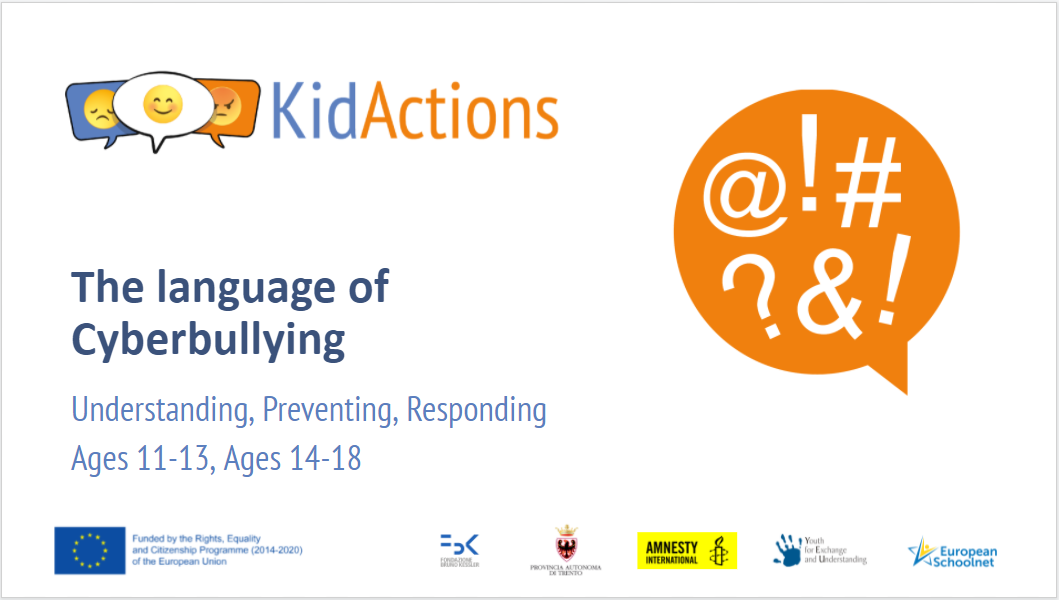Timing: 40 minutes
Learning outcomes: learners will be able to…
- Recognise patterns in language used in cyberbullying.
- Consider advice for their peers and others on how to respond to cyberbullying language.
Key vocabulary: cyberbullying, hate speech, linguistics, patterns, behaviour, keywords, responding, positively challenge, reporting.
Resources: Google Slides
Key questions:
- What sort of words does a cyberbully use?
- How could we spot these words online? (e.g. social media, online games, chat forums, etc.)
- Are there patterns in how cyberbullies behave and vocalise their attacks?
- How would you respond to cyberbullying language if…
- …you were the target?
- …you were a friend of the bully?
- …you were a bystander?
- Which strategies allow you to respond positively? (i.e. to make the situation better, not worse.)
- What advice would you give to other young people your age on how to deal with cyberbullying language online?
PLEASE READ THESE DOCUMENTS BEFORE STARTING THE ACTIVITY
Starter activity (10 minutes)
The language of a bully
Explain to young people that this session is about the language that cyberbullies may use when targeting others online, and what steps we can take to positively and safely respond to this abuse.
(NOTE: The following activity will produce examples of language that might be deemed offensive. It is important for learners to understand that using this language is only acceptable for the purposes of this starter activity to collect examples, and that their chosen examples may be offensive to others in the group.)
As a class/group, give learners two minutes to individually consider the type of words and insults a bully might use. They should record these on a piece of paper. Ask learners to look over their words and consider if they can be grouped together (e.g. negative words/phrases about race, gender, sexual identity, negative words/phrases about a person’s appearance, insults directed towards people/things valued by a person.)
DO NOT ask learners to share their words/phrases, as this may cause offense or upset to others.
After the activity, they must destroy their list of words (e.g. rip up their paper, delete a document, etc.). This is to ensure that their offensive words can no longer be seen by anyone else, but also to signify that this activity has ended and those lists are no longer required.
Activity (20 minutes)
The language of a cyberbully
Ask learners for their thoughts and views:
- What sort of language is most common/most frequently shared?
- Where is this shared online?
- Who do you think posted/shared this type of language?
- What do you think their motives were?
Based on the discussion and any conclusions, ask learners to work in pairs/small groups to write down 3-5 top tips on how someone could respond if they encountered this language online.
Responses might include sending a message, posting some form of content, using online tools to help or another method designed to seek help/support.
The tips should be considered for the following audiences:
- A target of the cyberbullying
- A friend of the cyberbully
- A bystander who does not know the bully or target
Depending on the time available, you could ask learners to think of tips for each audience in turn, or assign one audience to each pair of learners, ensuring that all three audiences will be covered.
Ask learners to share their top tips for each audience and discuss the following questions:
- Do your responses make the situation better or worse?
- Do any of your responses affect your safety or that of others?
- Which of your responses would have the greatest impact?
As a class/group, discuss the preferred strategies for each audience – which would be the most important tip for each audience?
Plenary (10 minutes)
Ask learners to plan how they could share their top tips with their chosen audience e.g. a poster, online message such as a tweet or post, audio recording, infographic, flyer, etc. If more time is available, learners could create their chosen media containing their top tips. If appropriate, they could share these with their school/local community, offline or online.
